An Artist’s Almanac 2023 is a journey across the UK to discover the sustainable practices of artists whose work is rooted in the protection and conservation of the Earth. Documented by environmental photographer Benjamin Youd, in collaboration with the Land Art Agency & Collective, it features the work and process of 12 artists, as well as the environmental biodiversity of each artist’s geographical region. It’s a beautiful book, inspiring in its variety of approaches.
It’s also a brilliant illustration of creatives taking control of their work and how it is shown. The book will be funded via Kickstarter, so if you’d like to support it, you can pre-order a copy for £30.
Lesley Hilling is one of the artists featured. She makes complex and beautiful structures out of recycled wood and found objects, many of them personal to her. They’re like memory palaces, self-contained worlds made with a love and care that radiates from the finished pieces.
I meet her and Ben via a three-way Zoom call, to discuss the book and why they decided to take part in the project.
I start by comparing Lesley’s work to The Borrowers, then regret it even as I’m saying it, because it might be insulting to compare her intricate pieces to a children’s book. But she is delighted, saying that she always loved those stories.
When did you start using salvaged stuff in your work?
LH: I think it would have been in the 90s, maybe a bit before. I used to be a freelance graphic designer. I was one of the first to start using computers. So I had a lot more time but – for a while, at least – the same money. Which was good.
I’d always collected stuff. And my dad was a woodworker – he built a boat in the garden! So I started making things with my collection of stuff. They weren’t very good. They were very derivative, influenced by Joseph Cornell, Louise Nevelson. But I just kept going, and I think I’ve got my own voice now.
Isn’t that how we all start – by imitating, then finding our own way?
LH: Yes, I think you’re right.
Ben, what attracted you to the idea of documenting these artists?
BY: I’m passionate about are creativity in the arts, and sustainability. So it was the chance to explore both, from the point of view of the artists.
When did sustainability become an overt thread in your work, Lesley? Did that come after you’d started making the work?
LH: Not at all! I didn’t ever want to buy or make anything new. My partner Nel [Burke] and I have always felt that. Nel used to go on demonstrations with a big placard saying, ‘Stop Shopping And Have More Fun!’
There’s too much stuff in the world, so I didn’t want to make anything new. I wouldn’t have become a potter or used wood that hadn’t been used for something else. I’ve always liked the worn-ness of things, as well. All my clothes are generally second-hand – except for the underwear and the shoes! It’s about them being owned by someone else first, having that history.
A lot of the stuff you repurpose is personal to you: things that belonged to friends or family. But I felt really connected to it. There were things I remember from my childhood: Airfix models, toy cars, packaging.
LH: Yes! It’s about collective memory, really.
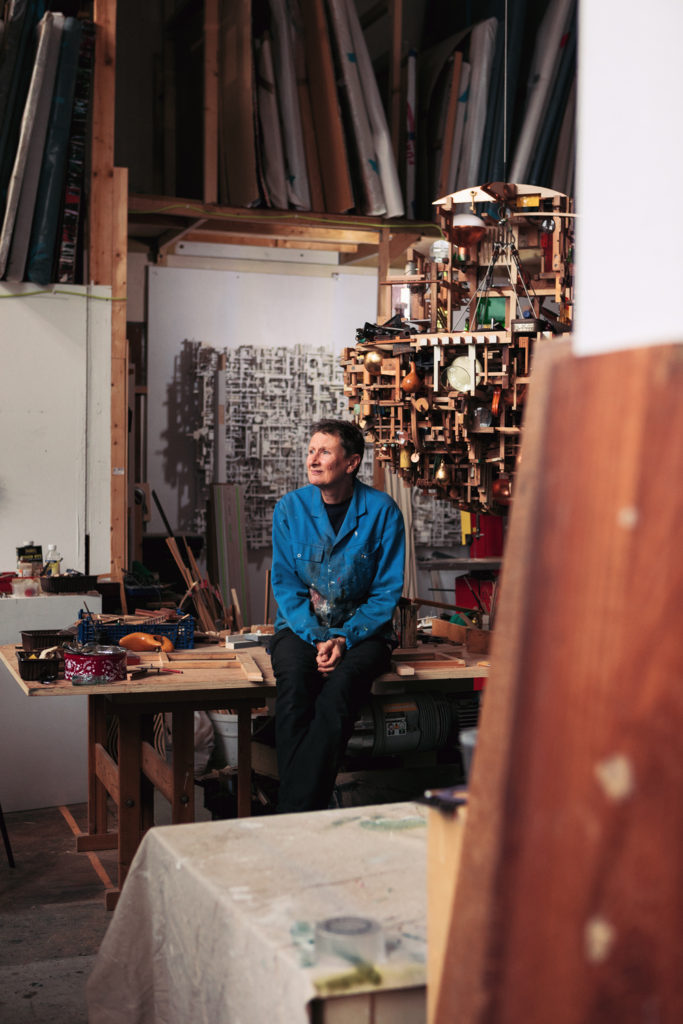
Art has always helped propagate ideas, and it’s always been at the vanguard of social change. Is it important that it gets involved in Green politics?
LH: Yes! We’ve only got one world. And class politics are important, as well.
Is that why you’re doing this book?
LH: It’s also for young artists who perhaps don’t want to go down the path of doing things that are just ideas-based. It’s a great inspiration for younger people. And for anyone who wants to make stuff.
Where do you get your ideas, and what do you do if you’re feeling stuck?
LH: When I don’t feel like doing anything, I go through my stuff. [She rotates her laptop to show us shelves of toys, photographs, glass valves, bits of wood.] If I start sorting through all of this rubbish.. Look, there’s some test tubes in there. And that will inspire me. That’s all I need, really: the stuff. It’s about the stuff, I think.
So if in doubt, have a rummage?
LH: Yes. I might pick something up, like an old thermometer or something, and that might inspire me to make something. And of course, there’s other people’s work. Looking at books. It’s better than the Internet! Taking a physical book and seeing other people’s work is so inspirational.
BY: I get stuck quite a lot! I just tend to change whatever I’m doing. Instead of pushing at something that’s not going anywhere, I do something different, to take my attention away from it. If I get stuck for more than a day – which I often do; I often get stuck for a week or even longer – I just immerse myself in nature, go for lots of walks and completely disengage from what I was doing. I get back into spiritual practice like meditation, to still myself and just stop focusing on what’s not working. Then naturally, I’ll get unstuck at some point. It might take an hour; it might take days.
LH: I couldn’t do that! That’s the right way to do it, but when things aren’t going right, I’m obsessive. It’s like, “This fucker has got to be sorted! I have to do this. And I have to do it now.”
BY: I wish I was more like that sometimes. Because that’s a barrier for me. I need to take time away. Which is hard when I have a deadline. Maybe I should be more like you!
LH: Yes, we should mould ourselves into one. (laughs)
What keeps you going? What motivates you?
LH: When things are going well, it is so enjoyable. It’s like taking drugs or something. So you’re constantly wanting that enjoyment back. Making things just gives that to me. That’s the motivation – because it certainly isn’t money!
Do you have those flow times where you suddenly realise you’ve been working for hours and it feels like minutes?
LH: That’s the great thing about it! It makes up for all those times when things aren’t going well, and you’re really struggling.
Do you feel sad when the piece is done and goes to live elsewhere? Because there’s so much of you and your friends in each one.
LH: No! I’m always so pleased to get rid of stuff. Without a doubt. I’m 64 now, and I think, “What will happen to all this stuff? Someone will have to clear this out.” I’ve cleared out the flats of so many of my friends who’ve died, and then bought other people’s stuff at car-boot fairs. A lot of the stuff I feel very tender about, I now want to put into my work, so that it will live on.
I often give people a bit of a discount if they’ve got kids. Because they might leave this to their kids and it will have precious things in it that were my mum’s, or something like that. When I was in my 40s, I only used photographs of people I got from car-boot fairs. No one I knew, because I didn’t want to lose my valuable, precious stuff. But now, it’s all change. We need to try and make those things live on.
What habits and routines serve you creatively? Do you have a ritual when you go into your studio, for instance?
LH: First, I water all the plants on the balcony. Then there’s often things like clamps that I’ve left on things glueing overnight, so I take the clamps off. That gets me going. Then I’ll be pottering about and Nel – who’s got a studio next door – will make some coffee, and toast. We’ll have that, then it’s full steam ahead until lunchtime.
BY: Coffee works for me. I start with coffee, every single morning. As a photographer, I’m here, there and everywhere. But I really value my headspace. If I’m going into London, for example, and I don’t have to bring loads of stuff, I go by train. Then I can have my coffee, do a bit of reading, and just centre myself before I start whatever I’m doing.
If I’m at home [in Sussex], I like to meditate in the mornings, just to clear my mind and prepare me for the day. It’s all about just clearing everything else out. Because I can get quite overwhelmed by things.
Do you have a book that always inspires you?
LH: There’s a MOMA New York book, Joseph Cornell, that I go back to time and time again. And then there’s a book of Leonardo Drew’s work, Existed, that I look at over and over. A reading book would be Italo Calvino’s Invisible Cities, which is very poetic and inspiring. But I tend to read thrillers most of the time.
BY: There’s a photo book by Alec Soth I really like, called Sleeping by the Mississippi. It touches on what Lesley said about Invisible Cities. It’s like a poem. But in visual form, so you can dip in and out of it. Every time I look at it, I get something new. I just love it.
If I’m feeling a bit stuck I’ll look at that, or one of his other books. It’s not the kind of photography I do. But it just really speaks to me in a beautiful, positive way, and re-engages my creative spirit.
Have you learned anything, Ben, while documenting these artists at work?
BY: It’s taught me about myself, how I like to photograph. I’ve done commercial work, corporate work, editorial. But what I really enjoy is getting to know people, slowing down and paying attention to who they are and what they’re about.
I’m also an introvert so I don’t particularly thrive on the kind of work where you have to be this big personality. I can do that, but it’s pretending and I feel really drained after. Just having that one-on-one time, getting to know the artists and observing what they’re doing in their practice has been wonderful. That’s the sort of work I’d like to keep on doing, and the way I’d like to use photography. Just go a bit slow, a bit quieter, and get to know people in an organic way.
LH: And because Ben is a quiet, introverted character, it never felt like an intrusion. It was nice. Very nice.

You’re crowd-funding the book. Which is exciting, because it removes the gate-keepers; you no longer have to convince a publisher. But it can also be pressure, because you’ve got to raise the money within a certain time-frame. How do you feel about that?
BY: I’ve found it both liberating and stressful in equal measure! It’s great in that you have a lot of control. Together with Land Art, we’ve got control over the way we promote it, the way we design it, who we approach. But it is quite nerve-wracking wondering if you’re actually going to complete what you’ve set out to do, and raise all the funds you need. There’s a lot of work involved in terms of promoting and reaching out to the right people. And you don’t know if it’s going to pay off.
It means so much to have support from people interested in the project, and it’s exciting to see it taking steps towards being fully funded. Any support is so appreciated, and it offers a direct way for contributors to be part of the book and the land art community – with every donator getting their name in the book credits.
We all need to be doing more to protect our planet and conserve it. And the arts is definitely a way of doing that. People involved in this project are all doing that quite successfully, in their different ways. The book is a celebration of that.
LH: I find it difficult. We crowd-funded an exhibition back in 2013, and I found it really stressful. The key word here is passion. All the artists involved – including me – are really passionate about what we do. It’s just so difficult to get that across on a computer screen, when you’re doing something like a Kickstarter. But it’s the most important thing about the book, I think: the way we feel about our work, and about the environment.
The Kickstarter to fund An Artists Almanac closes on August 31. Click here to support it.

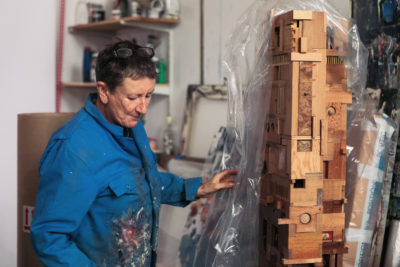
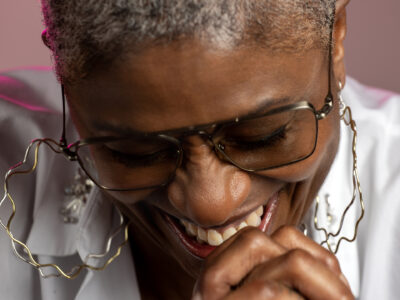
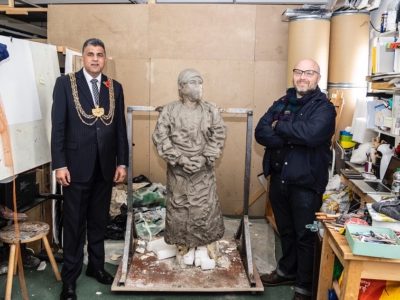
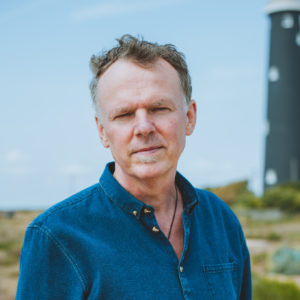
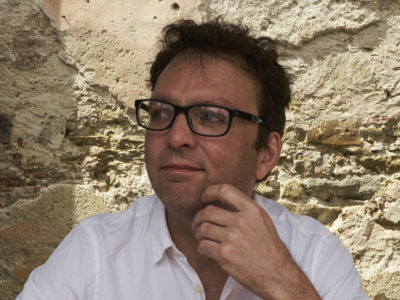
What do you think?